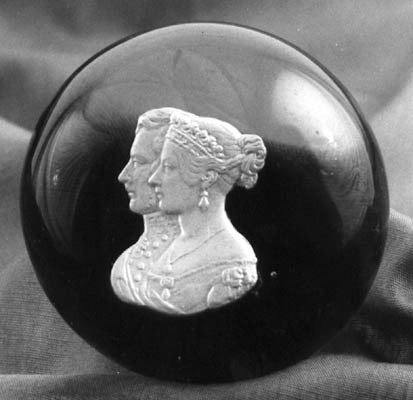
Havens, J. M., 1990:
Paperweight find: an adventure in antiquing, Glass Collector's Digest,
Vol. 4, No. 3, pp. 90-92

This hemispherical sulfide paperweight of colorless, lead glass was found
several years ago in a general-line dealer's booth at an antiques mall in
upstate New York. The images of Queen Victoria and Prince Albert were
immediately identifiable based on general knowledge but were obviously unknown
to the seller who had priced the weight at only $31.
Apparently a considerable, but known, number of these weights were produced
after the marriage of the queen and her consort in 1840 and before his death in
1861. The first recorded example is probably the one shown in Evangeline H.
Bergstrom's pioneering study OLD GLASS PAPERWEIGHTS, first published in 1940,
where the weight is attributed to the New England Glass Works. This attribution
was generally held until the 1970s when a peculiarity in the construction of the
weight was taken into account. There is a shallow, depressed ring, the width of
a pencil line, running around the weight some distance above its base. Because
this characteristic is found on many paperweights known to have been made by the
French firm of M. Maes, Clichy-la-Garenne, usually referred to simply as Clichy,
it is now believed by many collectors that these Victoria and Albert weights
were manufactured by this firm.
The Bergstrom weight is part of the extensive collection housed in the
Bergstrom -- Mahler Museum in Neenah, WI where it is currently described as
"origin unknown, possibly Clichy, 1840-51" (Casper 1989). An identical weight,
but one that has had its sulfide "realistically colored" is shown in the Corning
Museum of Glass exhibition catalog PAPERWEIGHTS: "FLOWERS WHICH CLOTHE THE
MEADOWS", where it is described as having been made in "France, possibly Clichy,
ca. 1845-55" (Hollister and Lanmon 1978, pp. 116, 144). At the time of this exhibition, 1978, it was part of the
paperweight collection at The Art Institute of Chicago. Other discussions of the
weight assign its origin to Clichy without qualification. It is interesting to
note that Clichy exhibited paperweights at the first of the major international
expositions, the Great Exhibition of the Works of All Nations, enthusiastically
backed by its royal patron Prince Albert, and held in London in 1851. And Clichy
also exhibited paperweights at the smaller American exposition held in New York
two years later. The great English glass manufacturer, Apsley Pellatt, had made
and sold sulfides long before the London exhibition, but he is not known to have
produced any hemispherical paperweights.
Thus far the manufacturer of the sulfide medallion itself has not been identified. It will be equally important to discover the name of its designer. Medallions of quality were usually designed by noted sculptors and engravers of the day, and these molded compositions of clay and supersilicate of potash were often based on medals.
The Victoria/Albert sulfide is similar to a medal of the royal couple
designed by W. Wyon, R. A. and struck by the Royal Mint in 1851, but there are
significant differences. This medal was used by the New
England Glass Works to produce what is generally regarded as the first dated
paperweight made in this country. But it is not a sulfide. The conjoined image
was merely pressed into a molten piece of glass that was later ground and
polished (Hollister 1969).
In order to control multiple reflections the weight shown here was
photographed against a dark background. The sulfide mediallion actually "floats"
on a ground of colorless lead glass. This simplicity adds considerably to the
weight's charm. Also appealing, but impossible to photograph, is the appearance
of the sulfide under various lighting conditions. At a low angle of illumination
it takes on the sheen of solid silver, a characteric seldom present in modern
sulfides. The sulfide shows remarkably fine detailing which, unforunately, is
also impossible to photo-reproduce exactly. The weight has a diameter of 2.6"
(6.5 cm) and is about 1.9" (4.7 cm) high. Its base has a shallow, polished
pontil that is so large that it results in a very narrow basal ring of varying
width that has been ground and polished and shows considerable expected wear.
The weight is a cross-over collectible, of interest both to paperweight
enthusiasts and to collectors of British commemoratives. It re-sold for $300 in
1990.
Updated 1 Jun 2007